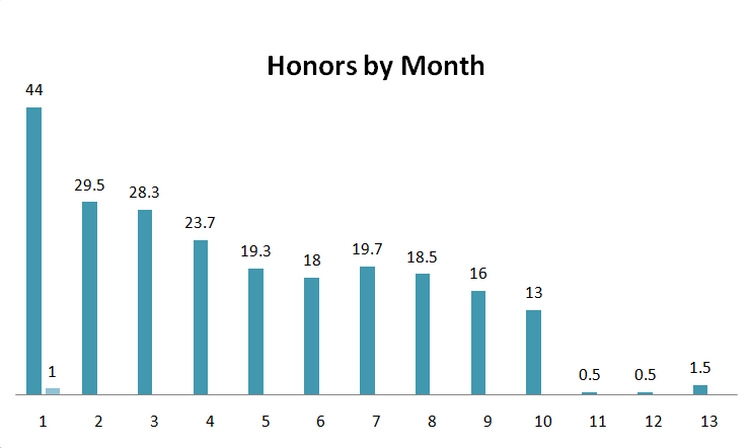
A simplified version of Karl Deutch's production function is
technology produces communication produces culture/community produces institutions
The 'power' in this production is exhibited with the rather trite phrase "the authoritative allocation of values." Deutsch used these ideas to understand the process of social mobilization in general and of changes going on in Europe [Deutsch, 1953]. He knew that the changing patterns of communication across European national boundaries would eventuate in a global union.
Dick Merritt used the same set of ideas in his study of the American colonies and the emergence of the 'united' states [Merritt, 1966].
One should certainly understand the nationalization of American politics in the twentieth century in these terms. Radio, telephone, and television were followed by the shifting of power to what had been the 'federal' government.
These ideas are important at this time because we stand on the edge of a revolution in communication that portends major social and political changes.
The barriers of time and space and language are being eroded 'in front of our eyes.'
The old institutions are decaying at an increasingly rapid rate. Oral communication becomes mobile as the tie to wires goes away, and the institutions of the past survive only by getting governments to guarantee their survival. Newspapers are a thing of the past though they hope to follow telephone companies to guaranteed existence by 'well kept' governments. 'Television' will survive only as production for a communication platform that looks nothing like the platform of the past.
The institutions replacing the old are symbolized by Google, YouTube, Facebook and Twitter. Google's 90 billion inquiries a month come from every nook and cranny across the globe [Rao, 2010]. YouTube is now delivering more than one billion views per day as multimedia communication expands beyond the constraints of the economic institutions of the past [Schroeder, 2009]. Facebook has just passed 375 million active users with only 100 million from the U.S.[Eldon, 2010] And Twitter has become the Acropolis for global public communication.
The technology has changed and continues to change at a faster rate than we can keep up with. The old institutions are going away. New institutions that do not know the barriers of time, space and language take their place.
We are at: technology produce communication and begins to produce culture/community
How this happens --
First, opportunity squandered
The election of Barack Obama as president of the United States was welcomed with enthusiasm around the world. One way to notice that enthusiastic global response is the viewership of his weekly address. President Obama, as presidents in the past, delivers a weekly address of approximately 5 minutes. However, instead of being a radio address it is a YouTube address; it is a White House made video placed on their channel on YouTube for easy access by viewers. Since YouTube is as easily accessible around the world as in the United States president Obama is broadcasting to the world.
And the world came. His first weekly broadcast was viewed 119K times in the first 24 hours and 252K times in the first month. That does not tell us much about 'the world.' However, YouTube assigns what they call honors to videos; in this case the honor is the xth most viewed political news video for a list of countries. If the address is one of the most viewed news videos in other countries that tells us about the world. The first video had honors in 44 countries outside the US. Penetration seems an understatement for this geographic spread of viewing his address.
That is the potential of joining this new technology of communication and a charismatic leader. The potential reach is close to global.
The story does not have a particularly happy ending. This figure shows the number of honors for his weekly address averaged by month.
 |
It started with 44 countries. Then it fell to the 20s. Then the teens. And in November of 2009 the world walked away. One might argue that this was the world walking away because he is, after all, president of the United States.
But this figure belies that argument.
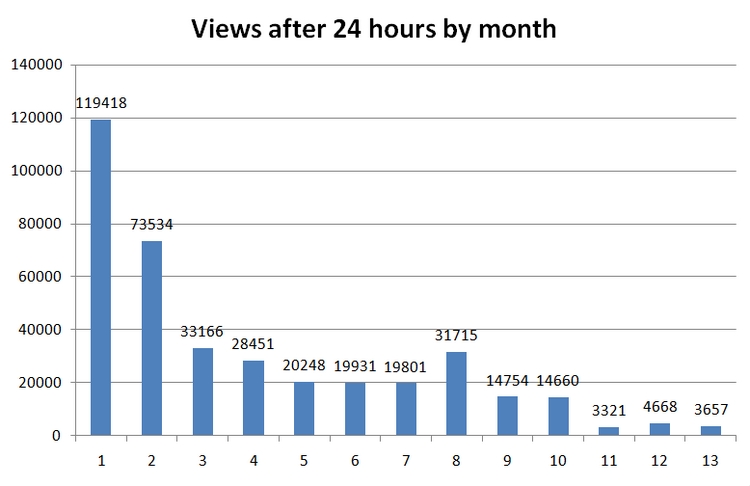 |
This is the number of views, from the US and elsewhere, after the first 24 hours averaged by month. The first weeks are high. By April views fell to the 20Ks. Then the teens in early fall. And finally everyone walked away from November on.
The importance of the story is not the ending but the beginning. The technology of communication that is part of our everyday life today provides a global reach for political leaders. Future leaders will be more adroit at using this technology to address the world.
How this happens.
Microblogging
Having started with a story about unrealized potential let me now turn to a story about potential realized. That is microblogging.
Microblogging is the constitution of a public domain in which people from all over the world -- with some notable exceptions -- can build communication relationships that are not limited in time or space or language.
One might think of microblogging as an isolated individual pumping brief messages out into the electronic night, and there is some of that. But much more common is streams of messages. Individuals with similar interests communicating about what is happening and how to understand it.
What I want to do is show you a few of those so you can have a sense of the message streams that are being created many times a day.
Google announced that they were tired of censoring for the Chinese government and they were going to renegotiate the deal. This is the stream that resulted.
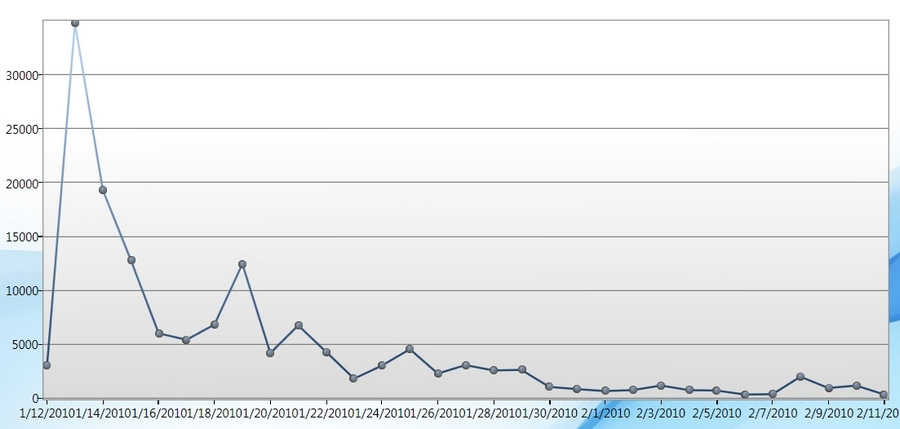 |
Their announcement was late evening so there were roughly 3,000 messages that evening, but the next day there were 35,000 messages about their announcement. Then there were 20,000 and 13,000 and 5,000 and 13,000 and the microblogging continues. A month later there are still around 2,000 messages a day -- which appears small only relative to 35,000. There have been more than 144,000 messages in the month.
Bin Laden has been around longer than Google-China, and I have captured that message stream from early in September through the present. This is the stream.
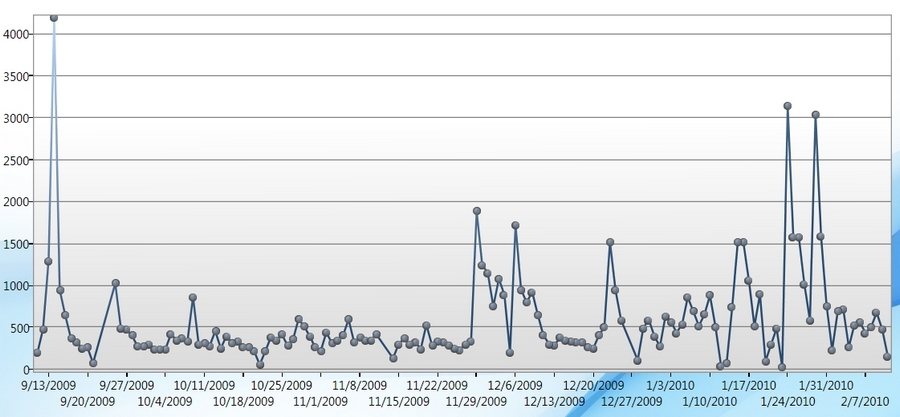 |
With each of his public announcements the messaging spikes, but he is always present in this communication stream. He is always present in the world's imagination -- to the tune of 80,000+ messages over that time period. If you want to learn how Bin Laden is understood this is a good place to look.
But 'terrorism' does not stop with Bin Laden. This is the stream defined simply by the word terrorism.
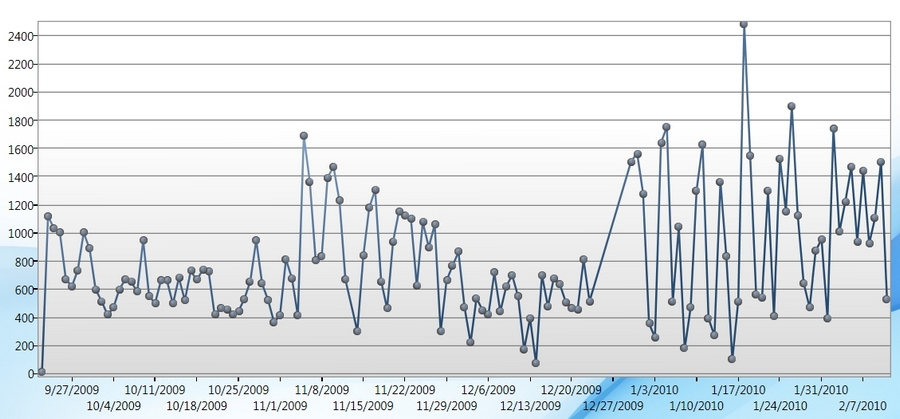 |
There are more messages about terrorism than about Bin Laden and they are responses to a broader range of 'terrorist' activities. The stream is only a couple of weeks shorter than the Bin Laden stream and there have been more than 102,000 messages.
Tracking "terrorism" is rather like tracking "suicide attack."
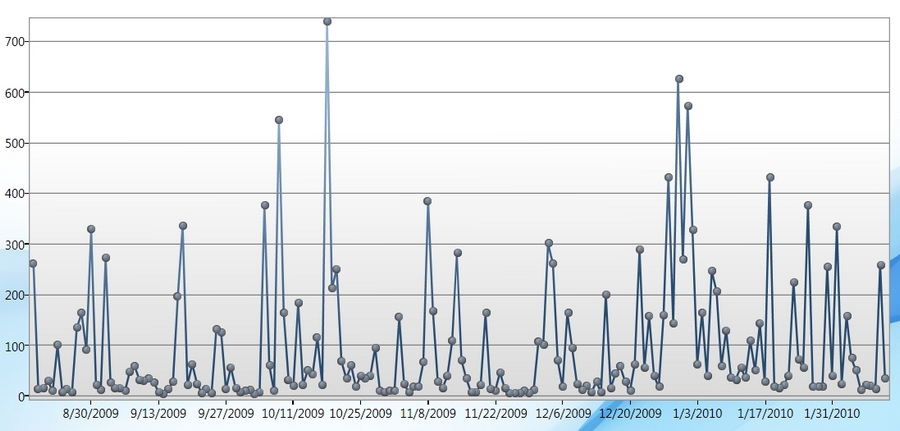 |
Messages about "suicide attacks" fall to practically zero, but they spike quite regularly with the incidence of attacks.
Multi-faceted streams
I have given you a simple view of these streams, but they are usually not simple. If they are more than a single spike they are usually multi-faceted. The meeting in Copenhagen by the nations of the world and many supporters and opponents of action to improve the environment can illustrate how multi-faceted these streams become.
This is the first one I noted. It is specified as "copenhagen treaty," and it was largely a stream of messages opposing the arrangements being made in Copenhagen. Sovereignty they were prone to 'shout.' And they were regularly in denial about coming global environmental problems.
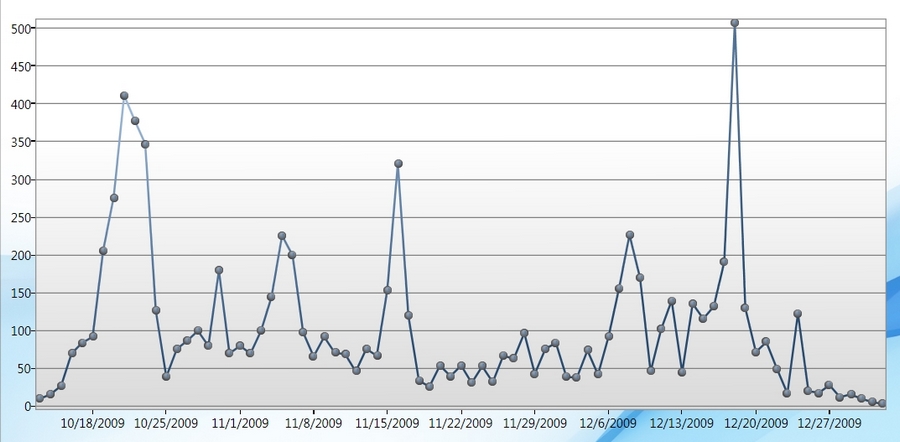 |
The stream begins in early October and runs through the end of the year with a total of 8,000+ messages.
The principal communication stream for the meeting was #COP15. Notice the convention used by microbloggers to identify a stream. #COP15 is added to each message, and people interested in communicating about the meeting can search for that tag to get news and expressions of opinion.
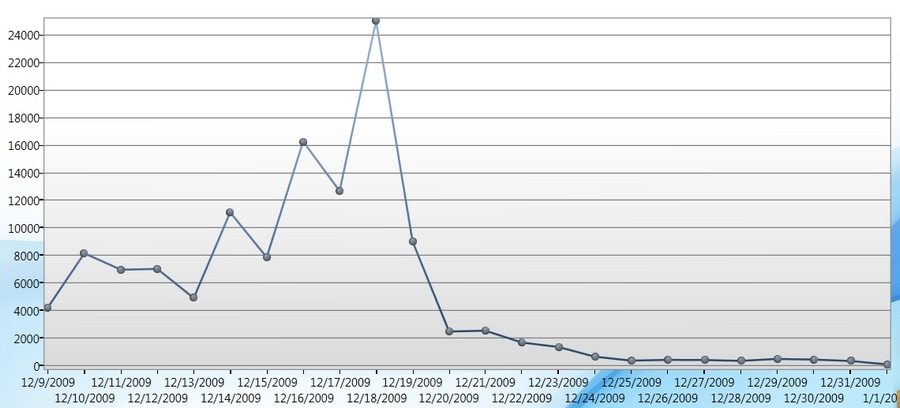 |
I picked up the stream in early December. It spiked on the 18th when 25,000 messages included #COP15. It declined after that as the meeting was over, and by the end of the month it was 'over' with 123,000 messages at that point.
The next two streams are single event spikes. The first is about the emergence of the treaty from the bargaining. There was speculation December 8 and 12 about when the treaty would become public. Then the big spike about the treaty having been issued.
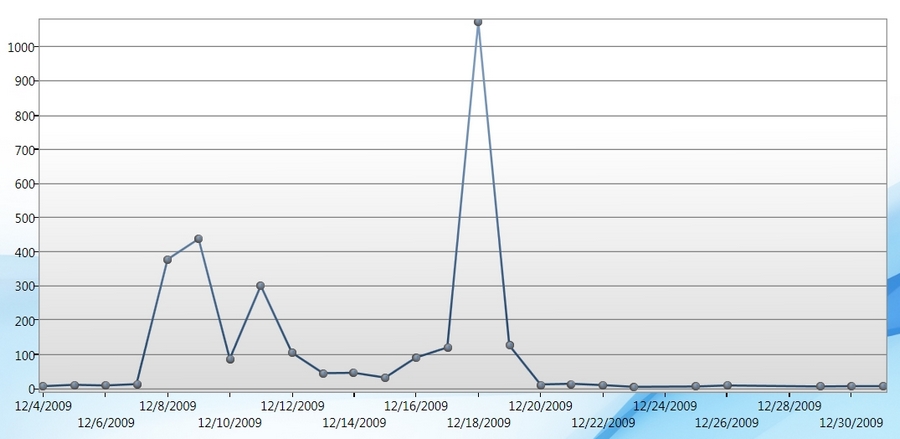 |
This speculation was captured in 2800+ messages.
And there was speculation about Obama attending the meeting. The meeting overlapped with his trip to pick up the Nobel Peace Prize. Would he attend? Or wouldn't he? It looked like the Nobel Peace Prize would win out over COP15. In the end he made a brief appearance leading to a considerable number of rebukes from supporters of the treaty.
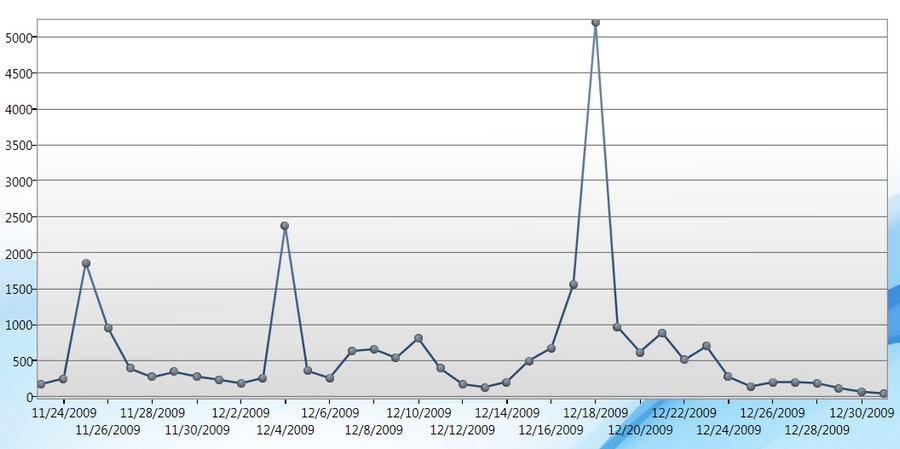 |
Spike for the appearance of the treaty on the 18th and a spike for the appearance of Obama on the 18th. The Obama stream was considerably more substantial with 24,000 messages.
This is the organization tcktcktck. It is a 'social network' including twitter messages for supporters of cleaning up the environment. Like the other streams it spikes on the 18th.
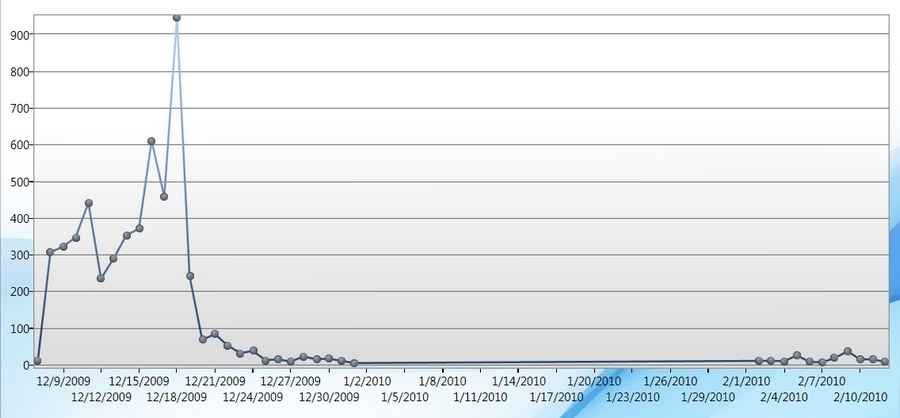 |
But it has a continued, if low volume, existence.
Back to Karl Deutsch
Deutsch counted mail flows because he knew that important social and political changes would be wrought from those mail flows. Today we can count message flows, and we have the advantage that we can read the messages.
Karl Deutsch was 80 when he died in 1992. The EU was established in 1993. He did not live to see the full fruition of his theoretical commitments. The changes are year by year, decade by decade, and reach fruition generation by generation.
This is an exciting time in the development of global communication, and this is an invitation to join me in doing the research to clarify, explicate, and theorize about those changes. If you are interested, if you know anyone who is interested -- I have collected more than 90 streams like these and I would be very happy to find others who wanted to use them to share the learning.
It's easy. Just follow me as bobboynton on Twitter.
References
Karl W. Deutsch (1953) Nationalism and Social Communication, Cambridge, New York MIT Press-Wiley
Eric Eldon (Feb 1, 2010) Facebook Traffic Reaches Nearly 375 Million Monthly Active Users Worldwide, Led by US, Inside Facebook
Richard L. Merritt (1966) Symbols of American community, 1735-1775, New Haven, Yale University Press
Leena Rao (Jan 22, 2010) Google Reigns Supreme in 2009 Worldwide Searches But Microsoft Sees Faster Growth, TechCrunch
Stan Schroeder (October 9, 2009) YouTube Reaches One Billion Views Per Day, Mashable